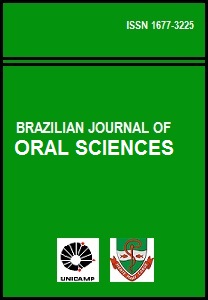Abstract
Aim: To evaluate the frictional force between the archwire and orthodontic bracket generated by elastomeric ligatures with polymer coating (Super slick, TP Orthodontics) and conventional ligatures (Morelli) using two types of insertion techniques. Methods: Forty elastomeric ligatures, 20 with polymer coating and 20 conventional, were evaluated. Each type of ligature was separated into two groups (n=10), according to the insertion mode: conventional or crossed (from mesial to distal region crossed in front). To analyze friction, 40 5-cm-long segments of stainless steel orthodontic archwire 0.019" x 0.025" (Morelli) and Edgewise brackets (slot 0.022" x 0.028"; Morelli) were used. Each set (bracket, wire and elastic) was submitted to frictional testing in a universal test machine (Instron 4411) at a crosshead speed of 5 mm/min. Each bracket was moved 5 mm on the wire, with maximum friction and mean friction being recorded by software. Three readouts were taken for each bracket. Data were submitted to two-way ANOVA and Tukey’s test (p<0.05). Results: It was shown that for maximum and mean friction, the polymer-coated ligature did not differ statistically from the conventional type in a dry environment condition. Ligatures placed in crossed mode promoted significantly greater friction than those placed in conventional mode, irrespective of the type of elastomeric ligature. Conclusions: Friction depended on the insertion mode, but not on the type of elastomeric ligature.
This work is licensed under a Creative Commons Attribution 4.0 International License.
Copyright (c) 2015 Flávia Ramos Venâncio, Sílvia Amélia Scudeler Vedovello, Carlos Alberto Malanconi Tubel, Viviane Veroni Degan, Adriana Simone Lucato, Letícia Nery Lealdim
Downloads
Download data is not yet available.

